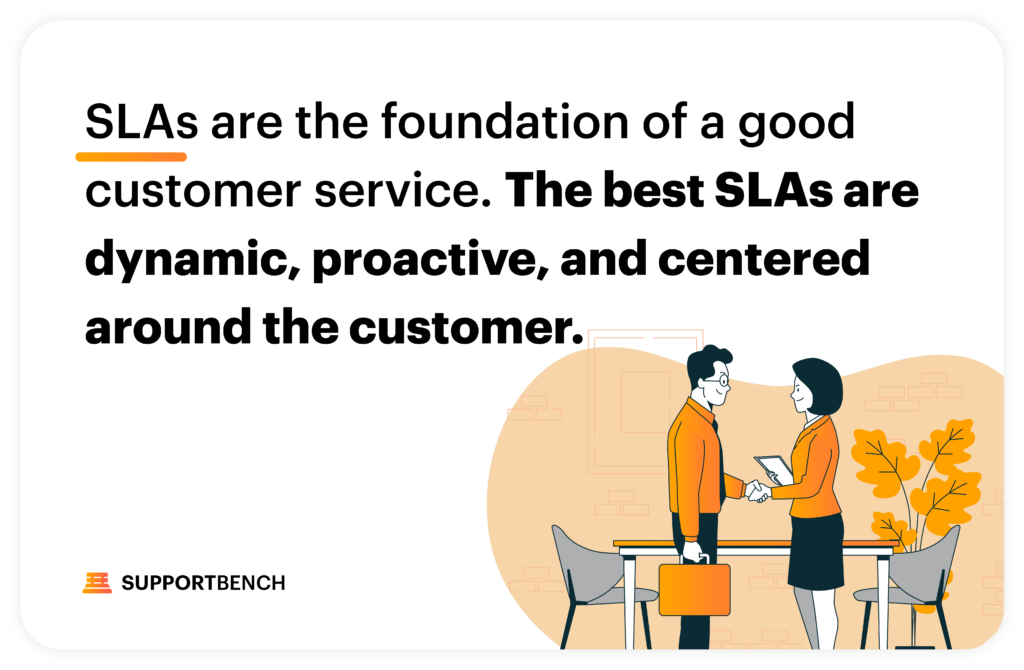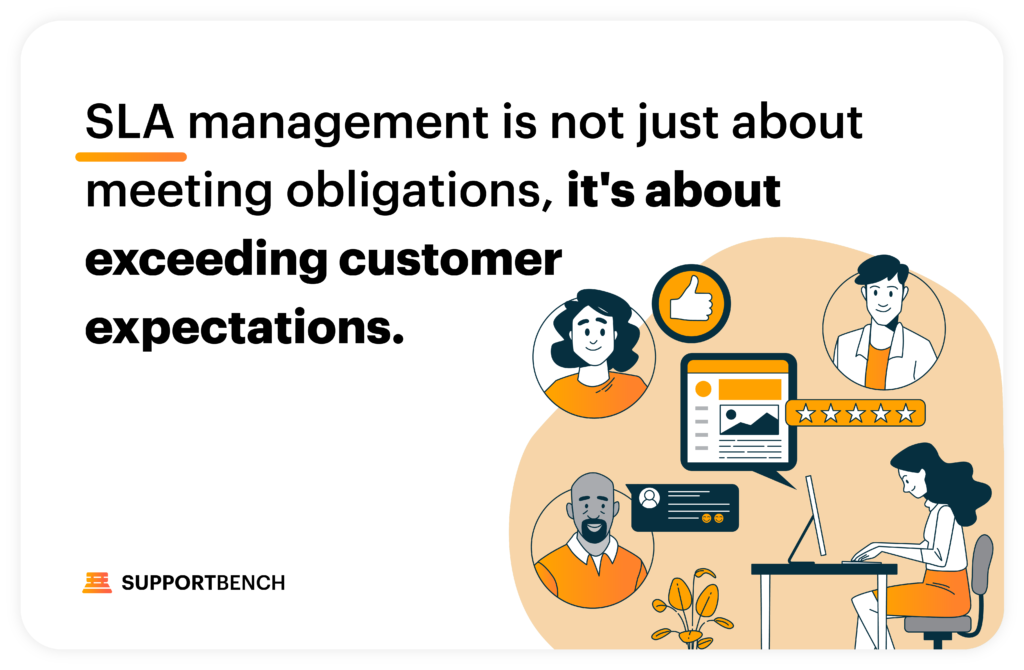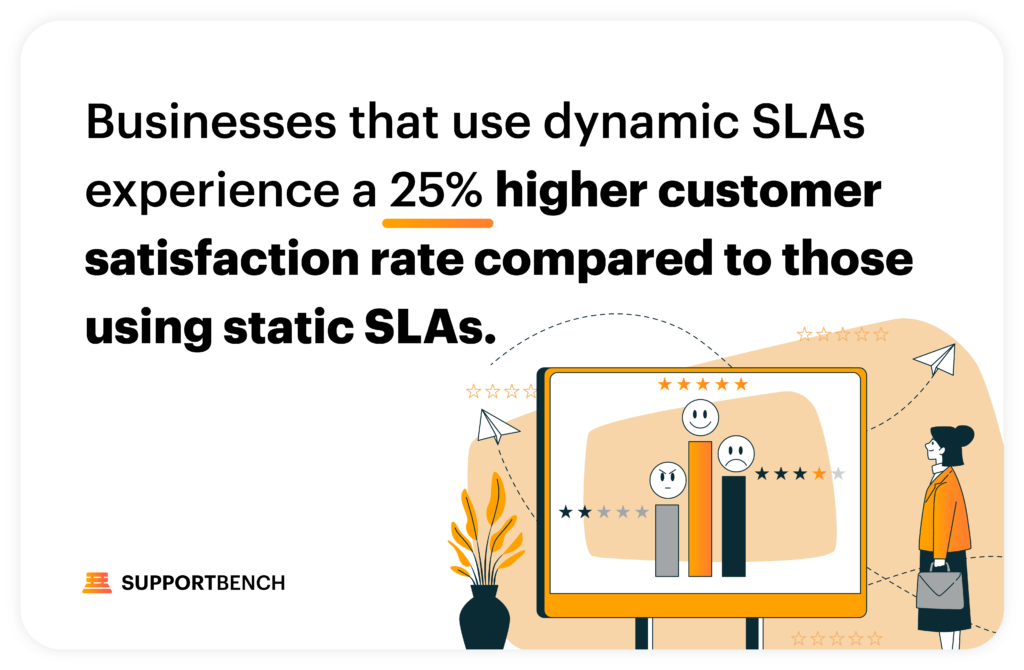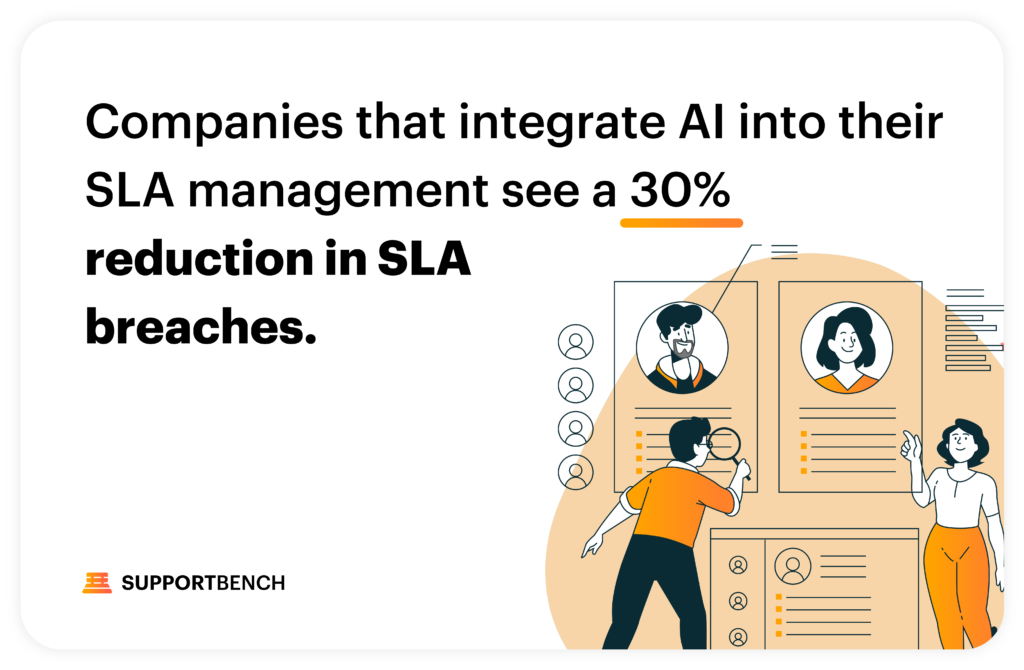Service Level Agreements (SLAs) have become the cornerstone of successful customer support, outlining the standards that customers can expect when interacting with your business. SLAs are no longer static, bureaucratic documents, but dynamic tools that can lead to improved customer experiences and satisfaction. Here, we delve into five key trends that are shaping SLA management in the B2B enterprise sector and provide actionable insights that leaders can use to improve their teams.
Shifting from Reactive to Proactive SLA Management

Traditionally, the primary focus of SLAs has been on reactive metrics such as response times and resolution times. But as customer expectations continue to evolve, it’s crucial for organizations to shift towards more proactive SLA management. This means anticipating potential issues and addressing them before they become problems that negatively impact the customer experience.
Understanding Proactive SLA Management
Proactive SLA management goes beyond merely responding to customer issues as they arise. It involves predicting potential problems and implementing solutions ahead of time to avoid service disruption or customer dissatisfaction. This approach requires an understanding of your customers’ behaviors, preferences, and expectations, along with the ability to use that information to forecast their future needs.
Steps to Implement Proactive SLA Management
- Invest in Predictive Analytics: Utilizing data analytics can help you anticipate future customer issues based on historical trends and patterns. For example, if your data indicates that a certain type of service request often leads to a specific problem, you can take steps to address that problem before it affects the customer experience.
- AI-Powered Automation: Artificial intelligence can play a significant role in proactive SLA management. AI tools can analyze vast amounts of data in real time, predict potential SLA breaches, and trigger preemptive actions. This could involve automatic rerouting of high-priority cases to senior team members or even immediate escalation to management when necessary.
- Effective Communication Channels: Keeping customers informed about any potential issue and the steps you’re taking to resolve it can significantly improve their experience. Make sure you have efficient communication channels in place for such updates. This can be a regular email update, a dedicated area on your website, or real-time notifications through a customer portal.
- Continuous Training: Your customer support team needs to be skilled at recognizing potential issues and addressing them proactively. Regular training sessions that equip your team with the necessary skills and knowledge can play a critical role in this.
- Feedback Loops: Incorporate customer feedback into your SLA management process. Regularly seek feedback from your customers to understand their pain points better and anticipate their needs.
Real World Benefits
Implementing proactive SLA management can provide several real-world benefits. These include:
- Improved Customer Satisfaction: By addressing potential issues before they escalate, you can significantly enhance the customer experience, leading to higher customer satisfaction rates.
- Increased Efficiency: Predicting and addressing issues before they arise can save your team valuable time, leading to increased efficiency.
- Reduced SLA Breaches: With proactive measures in place, you can significantly reduce the number of SLA breaches, thereby improving your compliance rates and enhancing your reputation.
- Strengthened Customer Relationships: Proactive SLA management demonstrates to your customers that you care about their experience and are committed to providing the best possible service. This can help strengthen your relationships with your customers and boost customer loyalty.
By making the shift from reactive to proactive SLA management, you can stay ahead of customer issues and ensure a smooth, satisfying customer experience. This proactive approach can not only help you meet your SLAs but also exceed customer expectations and establish your organization as a trusted, customer-centric enterprise.
Dynamic SLAs for Personalized Experiences

In an age of hyper-personalization, a one-size-fits-all approach to SLAs no longer suffices. SLAs need to evolve into dynamic agreements that are tailored to specific customer needs and circumstances. A dynamic SLA adapts based on a variety of factors such as customer importance, request complexity, and even the current mood of the customer.
Understanding Dynamic SLAs
Dynamic SLAs are not static documents; instead, they adapt according to real-time conditions. This adaptive nature allows organizations to provide a personalized level of service, addressing the unique needs of each customer and setting service-level targets that are both realistic and specific to individual circumstances.
Steps to Implement Dynamic SLAs
- Identify Differentiating Factors: To implement dynamic SLAs, first identify the differentiating factors that matter most to your customers and your business. These factors could be the customer’s lifetime value, loyalty status, the criticality of the service for the customer’s business, or even specific customer preferences.
- Segment Your Customers: After identifying key differentiating factors, segment your customers accordingly. This segmentation will form the basis for your dynamic SLAs. Each segment should have its own tailored SLA, reflecting the unique needs and expectations of customers within that segment.
- Automate SLA Rules: Use automation to adapt your SLAs in real-time. By linking your SLA management system to customer data, you can automatically adjust service levels based on predefined rules. For instance, a high-value customer’s service request could trigger a rule for an immediate response or a complaint from a long-standing customer could activate a fast-track resolution process.
- Continuous Monitoring and Review: Dynamic SLAs require ongoing monitoring and periodic reviews. Make sure you have systems in place to regularly track performance against SLAs, identify areas for improvement, and adjust SLA rules as necessary.
Real World Benefits
Implementing dynamic SLAs can provide numerous real-world benefits:
- Enhanced Customer Satisfaction: By tailoring your service level to meet specific customer needs and preferences, you enhance their overall experience and increase their satisfaction with your service.
- Improved Efficiency and Prioritization: Dynamic SLAs help your support team prioritize tasks effectively, focusing their efforts where they are most needed. This can lead to improved efficiency and productivity.
- Increased Customer Retention: By meeting and even exceeding customer expectations through personalized service levels, you can boost customer loyalty and retention.
- Stronger Competitive Advantage: In a marketplace where personalization is key, offering dynamic SLAs can differentiate your business from competitors, providing a unique selling proposition.
Implementing dynamic SLAs may require a change in mindset and possibly your systems. Still, the benefits of providing a more personalized and adaptive service to your customers are well worth the effort. The investment in understanding your customers’ needs and reflecting these in your service levels will pay dividends in customer loyalty, retention, and ultimately, business success.
Integrating SLAs with Customer Health Scoring

For a more customer-centric SLA management, consider integrating SLAs with Customer Health Scoring (CHS). CHS gauges the well-being of your customer relationships. By using CHS as an input to your SLA management, you can ensure the right service level is provided to the right customer at the right time.
Understanding the Integration
The concept of integrating SLAs with CHS involves using health scores to inform and adapt your SLAs dynamically. If a customer’s health score drops, it triggers an escalation in your service provision, ensuring struggling customers receive the attention they need promptly.
Steps to Implement CHS Integration with SLAs
- Define your Health Score Metrics: To start, define the metrics you’ll use to calculate customer health scores. This could include factors like product usage, frequency of service requests, NPS scores, renewal rates, and more.
- Segment Customers Based on CHS: After calculating health scores for each customer, categorize them into segments like ‘at-risk’, ‘needs attention’, and ‘healthy’. These segments will be the foundation for your dynamic SLA rules.
- Create Dynamic SLA Rules Based on CHS: Tailor SLA rules for each CHS segment. For instance, customers with low health scores could have faster response times, while healthy customers maintain standard SLA rules.
- Monitor CHS and SLA Performance: Regularly review your CHS and SLA performance. Look for trends in your data that might indicate changes in customer health and adapt your SLAs as needed.
Real World Benefits
When you effectively integrate SLAs with CHS, your organization can gain several real-world benefits:
- Proactive Customer Support: By aligning your SLAs with CHS, you can anticipate issues and intervene proactively before they escalate, thereby improving customer satisfaction and loyalty.
- Effective Resource Allocation: Integrating CHS with SLAs enables you to allocate your support resources effectively, prioritizing customers based on their health score and therefore need for attention.
- Improved Customer Retention: Proactively addressing the needs of at-risk customers can significantly improve customer retention rates, contributing to increased revenue and growth.
- Enhanced Business Insights: The data collected and utilized for CHS and SLAs can provide valuable insights for decision-making processes in various aspects of your business, from product development to marketing strategies.
Integration of SLAs with CHS, though requiring some upfront effort and resources, can lead to significantly improved customer satisfaction, better resource allocation, and enhanced customer retention. This strategic and proactive approach to SLA management puts your customers at the heart of your service delivery, leading to a healthier and more profitable business in the long run.
AI-Driven SLA Management

Artificial Intelligence (AI) offers substantial possibilities for improving SLA management. AI can automate routine tasks, predict potential breaches, and provide insights for optimization. Here’s how to leverage AI for your SLA management and enjoy its tangible benefits.
Understanding the Application of AI
AI can streamline your SLA management by predicting SLA breaches before they occur, automating ticket prioritization based on SLAs, and providing insights on SLA performance, among other things.
Steps to Implement AI-Driven SLA Management
- Identify Areas for AI Application: Look at your current SLA management process and identify areas where AI can add value. This could include ticket prioritization, predicting SLA breaches, or analyzing SLA performance.
- Choose the Right AI Tools: Depending on your identified areas, choose AI tools that best suit your needs. Some customer support platforms, like Supportbench, come with built-in AI capabilities for SLA management.
- Train Your AI Models: To ensure your AI tools can accurately predict SLA breaches and automate tasks, you need to train your AI models with relevant historical data.
- Monitor and Optimize: Regularly monitor your AI tools’ performance and use the insights provided by these tools to continually optimize your SLA management.
Real World Benefits
Implementing AI-driven SLA management can bring several benefits to your organization:
- Improved Efficiency: AI can automate routine tasks like ticket routing and prioritization based on SLAs, freeing up your team’s time to focus on complex customer issues.
- Proactive Support: AI’s predictive capabilities allow your team to foresee potential SLA breaches and take preventative action, thereby enhancing customer satisfaction.
- Data-Driven Decisions: AI tools can analyze your SLA performance and provide insights, helping your team make data-driven decisions to optimize your SLAs.
- Enhanced Customer Experience: With more efficient and proactive support, you can significantly enhance the customer experience, leading to improved customer retention and loyalty.
Embracing AI-driven SLA management is not just about staying current with technology; it’s about leveraging AI’s potential to drive efficiency, proactivity, and customer-centricity in your SLA management. By effectively implementing AI in your SLA management, you can make significant strides towards a more efficient, proactive, and data-driven customer support organization.
SLAs as a Customer Experience Tool
Service Level Agreements (SLAs) aren’t merely about technical aspects of service delivery. They can be a potent tool for enhancing customer experience when employed strategically. Here’s how you can use your SLAs to improve customer satisfaction and retention.
Redefining SLAs
Typically, SLAs focus on specific metrics like response times or resolution rates. To use them as a customer experience tool, you need to shift your focus from what you deliver to how your customers feel about your service.
Steps to Implement Customer-Centric SLAs
- Identify Your Customers’ Needs: Customer-centric SLAs start with understanding your customers’ expectations. Conduct surveys, interviews, or focus groups to learn what they value most in your service.
- Redefine Your SLA Metrics: Based on your findings, redefine your SLA metrics to focus on customer satisfaction. These could be time to first meaningful response, personalized solutions, or proactive communication.
- Communicate Your SLAs: Clearly communicate your SLAs to your customers. Explain what they can expect from your service, how you plan to meet these expectations, and how they can hold you accountable.
- Review and Refine: Regularly review your SLA performance from a customer experience perspective. Use customer feedback and other data to refine your SLAs continually.
Real World Benefits
Leveraging SLAs as a customer experience tool can yield several tangible benefits:
- Enhanced Customer Satisfaction: By focusing on what your customers value, you can significantly enhance their satisfaction, turning them into loyal advocates.
- Improved Customer Retention: Satisfied customers are less likely to churn, helping you maintain a robust customer base.
- Competitive Advantage: In a market where products and services are increasingly similar, excellent customer experience can set you apart from your competition.
- Increased Revenue: Happy customers not only stick around longer, but they also spend more. According to a study by Bain & Company, customers who rate a company high on customer experience spend 140% more than those who rate it low.
Redefining your SLAs from a customer experience perspective can result in tangible business benefits. It’s about moving beyond mere service delivery to creating delightful experiences that make your customers feel valued and respected. By strategically leveraging your SLAs, you can make your customer experience a key differentiator for your business.
Summing it All up
In today’s competitive business environment, successful SLA management is about much more than just meeting contractual obligations. By staying on top of the latest trends and implementing these actionable insights, leaders can use SLAs as a powerful tool to deliver consistent, high-quality customer experiences.
At Supportbench, we understand the importance of effective SLA management and have designed our customer support software with this in mind. By providing advanced features such as dynamic SLAs, AI-driven analytics, and integration with customer health scoring, we enable businesses to deliver personalized, proactive customer service that drives satisfaction and loyalty. While we’re not here to sell, we believe in the value that our approach brings to SLA management, creating a customer-centric environment that benefits both enterprises and their customers.
SLA management is an essential component of any successful customer support strategy. By staying abreast of the latest trends and implementing these actionable insights, you can ensure that your SLAs serve not just as contractual obligations, but as powerful tools to deliver consistent, high-quality customer experiences.











